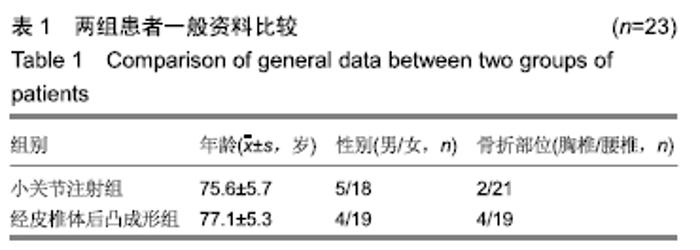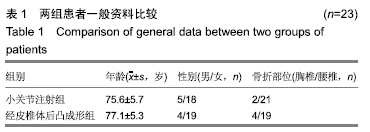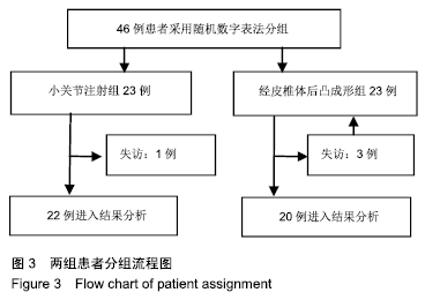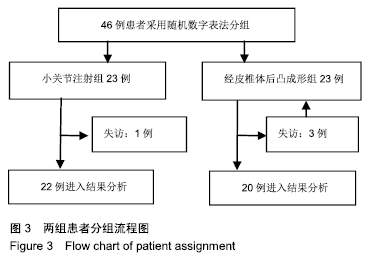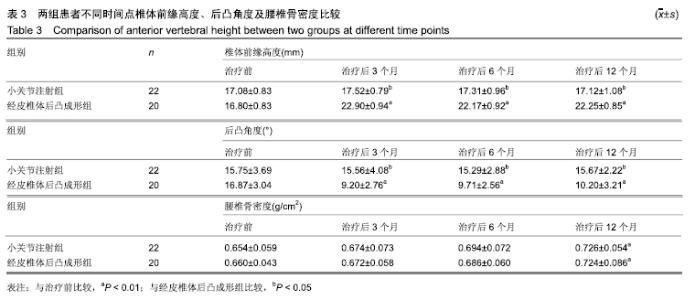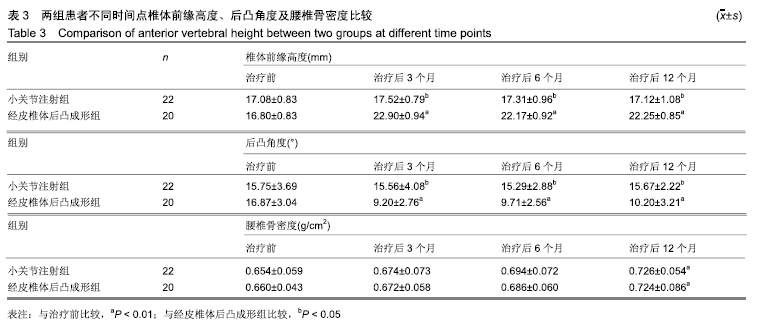[1] 中华医学会骨质疏松和骨矿盐疾病分会.原发性骨质疏松症诊疗指南(2017).中华骨质疏松和骨矿盐疾病杂志, 2017,10(5): 413-444.
[2] LEE HM, PARK SY, LEE SH, et al. Comparative analysis of clinical outcomes in patients with osteoporotic vertebral compression fractures (OVCFs): conservative treatment versus balloon kyphoplasty.Spine J.2012;12(11): 998-1005.
[3] 居正烨,陈圣宝,张长青.骨质疏松性椎体压缩性骨折研究进展[J].国际骨科学杂志,2018,39(1):33-36.
[4] 邱贵兴,裴福兴,胡侦明,等.中国骨质疏松性骨折诊疗指南(骨质疏松性骨折诊断及治疗原则)[J].中华骨与关节外科杂志, 2015, 8(5):371-374.
[5] GOLDSTEIN CL, CHUTKAN NB, CHOMA TJ, et al. Management of the Elderly With Vertebral Compression Fractures.Neurosurgery.2015;77 Suppl 4: S33-45.
[6] SOLBERG J, COPENHAVER D, FISHMAN SM. Medial branch nerve block and ablation as a novel approach to pain related to vertebral compression fracture.Curr Opin Anaesthesiol. 2016;29(5): 596-599.
[7] GENANT HK, WU CY, VAN KUIJK C, et al. Vertebral fracture assessment using a semiquantitative technique. J Bone Miner Res.1993;8(9): 1137-1148.
[8] WANG B, GUO H, YUAN L, et al. A prospective randomized controlled study comparing the pain relief in patients with osteoporotic vertebral compression fractures with the use of vertebroplasty or facet blocking.Eur Spine J.2016;25(11): 3486-3494
[9] 朱婷,肖礼祖,单莉莉,等.超声引导下小关节注射治疗腰椎小关节综合征[J].中国疼痛医学杂志, 2015,21(3):202-205.
[10] 宗行万之助.疼痛的估价——用特殊的视觉模拟评分法作参考(VAS)[J].疼痛学杂志,1994,2(4):153.
[11] FAIRBANK JC. Oswestry disability index.J Neurosurg Spine. 2014. 20(2): 239-241.
[12] 邢庆娜,张小安,陆林,等.站立位脊柱DR全景成像和MSCT对脊柱侧弯Cobb角测量的价值比较[J].河南大学学报(医学版), 2014,33(1):56-59.
[13] MITRA R, DO H, ALAMIN T, et al. Facet pain in thoracic compression fractures. Pain Med.2010; 11(11): 1674-1677.
[14] WILSON DJ, OWEN S, CORKILL RA. Facet joint injections as a means of reducing the need for vertebroplasty in insufficiency fractures of the spine.Eur Radiol.2011; 21(8): 1772-1778.
[15] IM TS, LEE JW, LEE E, et al. Effects of Facet Joint Injection Reducing the Need for Percutaneous Vertebroplasty in Vertebral Compression Fractures.Cardiovasc Intervent Radiol. 2016;39(5):740-745.
[16] CLARK W, BIRD P, GONSKI P, et al. Safety and efficacy of vertebroplasty for acute painful osteoporotic fractures (VAPOUR): a multicentre, randomised, double-blind, placebo-controlled trial. Lancet.2016;388(10052): 1408-1416.
[17] FIRANESCU CE, DE VRIES J, LODDER P, et al. Vertebroplasty versus sham procedure for painful acute osteoporotic vertebral compression fractures (VERTOS IV): randomised sham controlled clinical trial.BMJ.2018;361: k1551.
[18] 陈锦平.骨质疏松性骨折的外科治疗[J].中国全科医学, 2010, 13(2):122-123.
[19] YANG EZ, XU JG, HUANG GZ, et al. Percutaneous Vertebroplasty Versus Conservative Treatment in Aged Patients With Acute Osteoporotic Vertebral Compression Fractures:A Prospective Randomized Controlled Clinical Study.Spine (Phila Pa 1976).2016;41(8): 653-660.
[20] 杨刘柱,陈仲,严鑫平,等.椎体骨水泥注入联合抗骨质疏松药物治疗急性骨质疏松性椎体压缩性骨折[J].中国组织工程研究,2014, 18(39):6265-6270.
[21] 杜浩,田笑笑,张晓强,等.经皮椎体成形术与保守法治疗老年骨质疏松性胸腰椎压缩骨折的疗效比较研究[J].中国全科医学,2013, 16(18):1629-1632.
[22] TSOUMAKIDOU G, TOO CW, KOCH G, et al. CIRSE Guidelines on Percutaneous Vertebral Augmentation. Cardiovasc Intervent Radiol.2017;40(3): 331-342.
[23] POLIKEIT A, NOLTE LP, FERGUSON SJ. The effect of cement augmentation on the load transfer in an osteoporotic functional spinal unit: finite-element analysis.Spine (Phila Pa 1976). 2003,28(10):991-996.
[24] 詹玉林,范家伦.腰椎小关节病的诊断与治疗[J].中国矫形外科杂志,2002,(8):94-95.
[25] 张广建,李仁淑,金文哲,等.脉冲射频治疗椎体压缩骨折性疼痛的疗效观察[J].中国疼痛医学杂志, 2016,22(5):386-388.
[26] 向醒,杨晶,张平,等.超声引导下腰椎小关节阻滞缓解经皮椎体后凸成形术术后残余疼痛[J].中国介入影像与治疗学,2017,14(6): 360-364.
[27] LEHMAN VT, WOOD CP, HUNT CH, et al. Facet joint signal change on MRI at levels of acute/subacute lumbar compression fractures.AJNR Am J Neuroradiol.2013; 34(7): 1468-1473.
[28] BOGDUK N, MACVICAR J, BOROWCZYK J. The pain of vertebral compression fractures can arise in the posterior elements.Pain Med.2010;11(11):1666-1673.
[29] 王彦凤,鄢建勤,李平.臭氧在慢性疼痛治疗中的应用研究进展[J].中国疼痛医学杂志,2019,25(4): 298-302.
[30] PARK KD, JEE H, NAM HS, et al. Effect of medial branch block in chronic facet joint pain for osteoporotic compression fracture: one year retrospective study.Ann Rehabil Med 2013; 37(2):191-201.
[31] 谢平,王英,艾登斌,等.脉冲射频联合康复治疗骨质疏松腰椎压缩骨折临床观察[J].中国疼痛医学杂志,2017;23(6):476-477+480.
[32] GARG B, DIXIT V, BATRA S, et al. Non-surgical management of acute osteoporotic vertebral compression fracture: A review.J Clin Orthop Trauma.2017;8(2): 131-138.
[33] 陈阳,马剑雄,马信龙.老年性骨质疏松骨折研究进展[J].中国骨质疏松杂志,2011,17(9):835-839.
[34] 秦丰伟.中医综合疗法和PKP治疗骨质疏松性椎体压缩性骨折的临床疗效对比研究[D].广州:广州中医药大学, 2014.
[35] 韦西江,苏汝堃.经皮椎体成形填充剂骨水泥渗漏的研究现状[J].中国组织工程研究, 2012,16(47):8853-8863.
[36] 黄卫国,易军飞,白瑞飞,等.椎体成形穿刺注射骨水泥防止灾难性并发症:87例137个椎体资料分析[J].中国组织工程研究与临床康复,2011,15(30):5669-5674.
[37] 桂先革,茹选良,蒋增辉,等.经皮椎体后凸成形术治疗骨质疏松性椎体压缩性骨折围手术期并发症分析[J].中国骨伤, 2013,26(3): 205-209.
[38] 游利.骨质疏松症的现状、筛查和预防[J].中国全科医学,2016, 19(14):1616-1619.
[39] COSMAN F, DE BEUR SJ, LEBOFF MS, et al. Clinician's Guide to Prevention and Treatment of Osteoporosis. Osteoporos Int. 2014;25(10): 2359-2381.
[40] 魏福堂,张洪涛.骨折患者长期卧床骨质改变与降钙素的预防[J].实用骨科杂志,2007,13(7):397-399.
|
